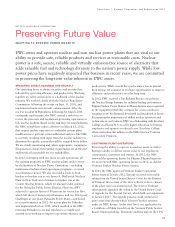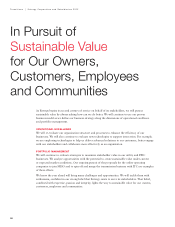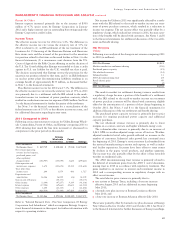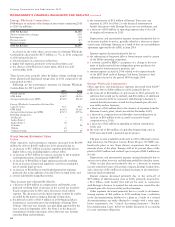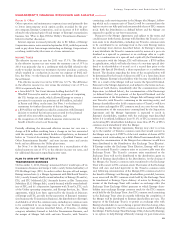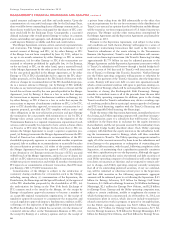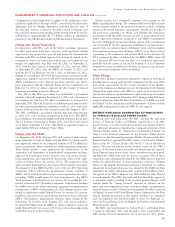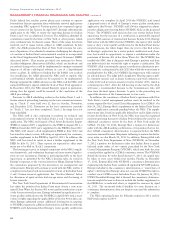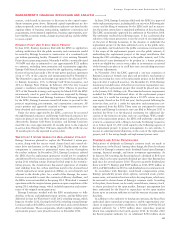Entergy 2012 Annual Report Download - page 28
Download and view the complete annual report
Please find page 28 of the 2012 Entergy annual report below. You can navigate through the pages in the report by either clicking on the pages listed below, or by using the keyword search tool below to find specific information within the annual report.Entergy Corporation and Subsidiaries 2012
MANAGEMENT’S FINANCIAL DISCUSSION AND ANALYSIS continued
of $45 per MWh based on market prices at December 31, 2012. Near-
term prices present a challenging economic situation for the Entergy
Wholesale Commodities plants. The challenge is greater for some of
these plants based on a variety of factors such as their market for
both energy and capacity, their size, their contracted positions, and
the investment required to maintain the safety and integrity of the
plants. If, in the future, economic conditions or regulatory activity no
longer support the continued operation of a plant it could adversely
affect Entergy’s results of operations through impairment charges,
increased depreciation rates, transitional costs, or accelerated decom-
missioning costs. Impairment of long-lived assets and nuclear decom-
missioning costs, and the factors that influence these items, are both
discussed below in “Critical Accounting Estimates.” See also the dis-
cussion below in “Entergy Wholesale Commodities Authorizations
to Operate Its Nuclear Power Plants” regarding Entergy Wholesale
Commodities nuclear plant operating license and related activity.
OTHE R IN CO ME STATEME NT ITE MS
Utility
Other operation and maintenance expenses increased from $1,951
million for 2011 to $2,080 million for 2012 primarily due to:
n an increase of $47 million in compensation and benefits costs
primarily due to decreasing discount rates and changes in certain
actuarial assumptions resulting from an experience study. See
“Critical Accounting Estimates – Qualified Pension and Other
Postretirement Benefits” below and Note 11 to the financial
statements for further discussion of benefits costs;
n $38 million of costs incurred in 2012 related to the planned
spin-off and merger of the Utility’s transmission business;
n an increase of $29 million in nuclear expenses primarily due to
higher labor costs, including higher contract labor;
n an increase of $21 million resulting from a temporary increase in
the Entergy Mississippi storm damage reserve authorized by the
MPSC effective August 2012. These costs included are recovered
through the storm cost recovery rider and have no effect on
net income;
n an increase of $14 million in energy efficiency costs at Entergy
Arkansas. These costs are recovered through the energy efficiency
rider and have no effect on net income;
n the deferral in 2011 of $13.4 million of 2010 Michoud plant
maintenance costs pursuant to the settlement of Entergy New
Orleans’ 2010 test year formula rate plan filing approved by the
City Council in September 2011. See Note 2 to the financial
statements for further discussion of the Entergy New Orleans
2010 test year formula rate plan filing and settlement; and
n an increase of $10 million in operating expenses due to the sale
of surplus oil inventory in 2011.
These increases were partially offset by:
n a decrease of approximately $7 million as a result of the deferral
or capitalization of storm restoration costs for Hurricane Isaac,
which hit the Utility’s service area in August 2012;
n the effect of the deferral, as approved by the FERC, and the LPSC
for the Louisiana jurisdictions, of costs related to the transition
and implementation of joining the MISO RTO, which reduced
expenses by $10 million; and
n a decrease of $9 million in legal expenses, not including legal
costs related to the transition and implementation of joining the
MISO RTO and the planned spin-off and merger of the Utility’s
transmission business which are included in other bullets,
primarily resulting from a decrease in legal and regulatory activity
decreasing the use of outside legal services.
Depreciation and amortization expense increased primarily due to
additions to plant in service.
Interest expense increased primarily due to a revision in 2011
caused by FERC’s acceptance of a change in the treatment of funds
received from independent power producers for transmission inter-
connection projects. Also contributing to the increase were net debt
issuances by certain of the Utility operating companies.
Entergy Wholesale Commodities
Other operation and maintenance expenses increased from $906
million for 2011 to $958 million for 2012 primarily due to:
n an increase of $23 million in compensation and benefits costs
primarily due to decreasing discount rates and changes in certain
actuarial assumptions resulting from an experience study. See
“Critical Accounting Estimates – Qualified Pension and Other
Postretirement Benefits “ below and Note 11 to the financial
statements for further discussion of benefits costs;
n an increase of $23 million primarily due to higher contract labor
costs and higher material and supply costs; and
n an increase of $20 million due to the operations of the Rhode
Island State Energy Center, which was acquired in December 2011.
These increases were partially offset by the effects of recording the
final court decisions in the Vermont Yankee and Indian Point 2 law-
suits against the U.S. Department of Energy related to spent nuclear
fuel disposal. The damages awarded include the reimbursement of
approximately $25 million of spent nuclear fuel storage costs previ-
ously recorded as operation and maintenance expenses.
The asset impairment variance is due to a $355.5 million ($223.5
million after-tax) impairment charge recorded in the first quarter
2012 to write down the carrying values of Vermont Yankee and
related assets to their fair values. See Note 1 to the financial state-
ments for further discussion of this charge.
Taxes other than income taxes increased primarily due to increased
property taxes at FitzPatrick, increased electric generating excises at
Vermont Yankee, and property taxes from the Rhode Island State
Energy Center acquired in December 2011. Previously, FitzPatrick
was granted an exemption from property taxation and paid taxes
according to a payment in lieu of property tax agreement. This agree-
ment expired on June 30, 2011 and FitzPatrick is now being taxed
under the regular property tax system. FitzPatrick has pending litiga-
tion in the Fifth Judicial District of New York State Supreme Court
challenging each annual property tax assessment placed on FitzPatrick
since the expiration of the payment in lieu of tax agreement. The
State of Vermont enacted legislation, which became effective on July
1, 2012, increasing the electric generating excise on Vermont Yankee.
Vermont Yankee is challenging the constitutionality of this legisla-
tion. In October 2012 the federal judge for the U.S. District Court for
the District of Vermont dismissed the suit on jurisdictional grounds.
In November 2012, Entergy appealed the District Court’s decision to
the Second Circuit Court of Appeals, where the suit remains pending.
Depreciation and amortization expenses decreased primarily due
to adjustments resulting from final court decisions in the Entergy
Nuclear Indian Point 2 and Vermont Yankee lawsuits against the
U.S. Department of Energy related to spent nuclear fuel disposal.
The effects of recording the proceeds from the judgments reduced
the plant in service balances with a corresponding $25 million reduc-
tion to previously-recorded depreciation expense. Partially offsetting
the adjustment was an increase due to additions to plant in service,
including the acquisition of the Rhode Island State Energy Center in
December 2011.
Other expenses decreased primarily due to a credit to decommis-
sioning expense of $49 million in the second quarter 2012 compared
to a credit to decommissioning expense of $34 million in the fourth
quarter 2011 resulting from reductions in the decommissioning cost
liabilities for certain nuclear plants as a result of revised decommis-
sioning cost studies. See “Critical Accounting Estimates – Nuclear
Decommissioning Costs” below for further discussion of these credits.
Entergy Corporation and Subsidiaries 2012
26



